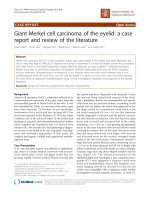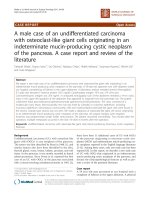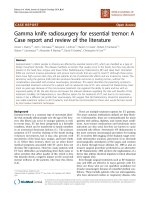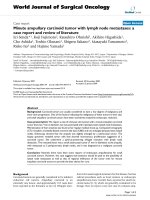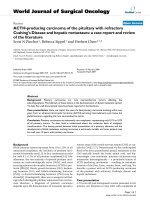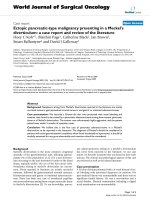Báo cáo khoa học: "Mesenteric rheumatoid nodules masquerading as an intra-abdominal malignancy: a case report and review of the literature" ppsx
Bạn đang xem bản rút gọn của tài liệu. Xem và tải ngay bản đầy đủ của tài liệu tại đây (824.41 KB, 5 trang )
BioMed Central
Page 1 of 5
(page number not for citation purposes)
World Journal of Surgical Oncology
Open Access
Case report
Mesenteric rheumatoid nodules masquerading as an
intra-abdominal malignancy: a case report and review of the
literature
Sumeer Thinda
2
and James S Tomlinson*
1,2
Address:
1
VA Greater Los Angeles Healthcare System, Los Angeles, CA, USA and
2
Department of Surgery, David Geffen School of Medicine UCLA,
Los Angeles, CA, USA
Email: Sumeer Thinda - ; James S Tomlinson* -
* Corresponding author
Abstract
Background: Rheumatoid nodules are the most common extra-articular findings in patients with
rheumatoid arthritis. They occur most commonly at pressure points such as the extensor surfaces
of the forearms, fingers, and occiput, but have also been reported to occur in unusual locations
including the central nervous system, pericardium, pleura, and sclera. We present the unusual case
of rheumatoid nodules in the small bowel mesentery masquerading as an intra-abdominal
malignancy.
Case presentation: A 65-year-old-male with a known history of longstanding erosive, nodular,
seropositive rheumatoid arthritis was incidentally found to have a mesenteric mass on computed
tomography (CT) exam of the abdomen. This mass had not been present on prior imaging studies
and was worrisome for a malignancy. Attempts at noninvasive biopsy were nondiagnostic but
consistent with a "spindle" cell neoplasm. Laparotomy revealed extensive thickening and fibrosis of
the small bowel mesentery along with large, firm nodules throughout the mesentery. A limited
bowel resection including a large, partially obstructing, nodule was performed. Pathology was
consistent with an unusual presentation of rheumatoid nodules in the mesentery of the small
bowel.
Conclusion: Rheumatoid nodules should be considered in the differential diagnosis of a patient
who presents with an intra-abdominal mass and a history of rheumatoid arthritis. Currently, no
tests or imaging modality can discriminate with sufficient accuracy to rule out a malignancy in this
difficult diagnostic delimma. Hopefully, this case will serve as impetus for further study and
biomarker discovery to allow for improved diagnostic power.
Background
Rheumatoid arthritis (RA) is a systemic inflammatory dis-
ease categorized as an autoimmune disorder, affecting
about 1% of the United States population[1]. The patho-
physiology is not completely understood but involves
inappropriate activation of B and T cells which stimulates
an inflammatory response most notably against synovial
tissues of the body causing the classic chronic inflamma-
tory arthritis[2]. This autoimmune disease is often associ-
ated with increased serum levels of Rheumatoid Factor
Published: 15 July 2009
World Journal of Surgical Oncology 2009, 7:59 doi:10.1186/1477-7819-7-59
Received: 23 March 2009
Accepted: 15 July 2009
This article is available from: />© 2009 Thinda and Tomlinson; licensee BioMed Central Ltd.
This is an Open Access article distributed under the terms of the Creative Commons Attribution License ( />),
which permits unrestricted use, distribution, and reproduction in any medium, provided the original work is properly cited.
World Journal of Surgical Oncology 2009, 7:59 />Page 2 of 5
(page number not for citation purposes)
(RF) which is an autoantibody against the constant region
(Fc) of immunoglobulin G (IgG) type antibodies. The
chronic inflammatory nature of this disease appears to be
driven by cytokines, most notably by TNFa[2]. The diag-
nosis of RA is based on a spectrum of clinical criteria as
listed in Figure 1[2]. Treatment of RA is founded in classic
immunosuppressive therapy combined with newer agents
targeting the specific inflammatory response of RA. An
example of these newer agents is etanercept, which is a
fusion protein combining the TNFa receptor with the Fc
portion of the immunoglobulin protein. This molecule
acts to dampen the effects of the excess TNFa released in
patients with RA driving the inflammatory reaction [2].
In addition to the classic symptom of chronic inflamma-
tory arthritis, RA is also associated with many extra-articu-
lar findings, including rheumatoid nodules, pyoderma
gangrenosum, pericarditis, pleuritis, felty's syndrome,
interstitial lung disease, glomerulonephritis, peripheral
neuropathy, scleritis, episcleritis, and vasculitis[1,3].
Rheumatoid nodules are the most common extra-articular
findings, occurring in about 25% of patients with RA[1].
Rheumatoid nodules occur most commonly at pressure
points such as the extensor surfaces of the forearms, fin-
gers, occiput, ischial areas, and the Achilles tendon[1].
They may also occur within internal tissues of the body:
central nervous system, heart, pericardium, lungs, pleura,
peritoneum, bones, vocal cords, and sclera[1]. Pulmonary
nodules have been associated with pleural effusions,
pneumothoraces, and fibrosis[4]. Cardiac nodules may be
noted on echocardiogram and can cause symptoms of
heart block and syncope[5,6]. There have been no reports
of rheumatoid nodules within the mesentery, and as is
exemplified by our case, this entity has the potential to
masquerade as a malignancy.
Case presentation
A 65-year-old-male with a known history of longstanding
erosive, nodular, seropositive rheumatoid arthritis pre-
sented with the chief complaint of persistent fevers. His
work up included chest and abdominal computed tomog-
raphy (CT) which demonstrated both a pneumonia and
an incidentally discovered mesenteric mass (Figure 2).
After the pneumonia was treated and resolved, surgical
oncology was consulted for further investigation of the
mesenteric mass. Upon questioning, the patient admitted
to intermittent crampy abdominal pain, occasional
diarrhea, and a 5 lb unintentional weight loss over the
previous 2 months. The patient's RA regimen consisted of
etanercept and methotrexate prior to his pneumonia but
these two immunosuppressive medications were with-
held secondary to his diagnosis of pneumonia and
workup for possible intra-abdominal malignancy. The
patient's past surgical history was significant for sigmoid-
Clinical criteria for the diagnosis of rheumatoid arthritisFigure 1
Clinical criteria for the diagnosis of rheumatoid arthritis. At least four of the seven criteria must be met for classifica-
tion as RA.
World Journal of Surgical Oncology 2009, 7:59 />Page 3 of 5
(page number not for citation purposes)
ectomy for diverticulitis and a cholecystectomy for symp-
tomatic cholelithiasis. Of note, there was no significant
family history of malignancies. On examination, the
patient was noted to have a well healed midline and right
upper quadrant scar, the abdomen was nondistended and
nontender to palpation, and no masses were noted.
Review of previous cross-sectional imaging studies
revealed that this mesenteric mass was not present 6 years
ago. Thus, malignancy was suspected, with the differential
including small bowel carcinoid tumor, metastatic adeno-
carcinoma, desmoid tumor and gastrointestinal stromal
tumor. Positron emission tomography (PET) with fluoro-
deoxyglucose (FDG) showed a moderately hypermeta-
bolic focus in the periumbilical anterior abdomen with
no other abnormal hypermetabolic foci (Figure 2). An
octreotide scan was negative. A percutaneous CT guided
needle biopsy was obtained and pathology revealed a
spindle cell lesion with an inflammatory background and
focal palisading necrosis; a spindle cell neoplasm could
not be ruled out. Immunohistochemical stain for CD117
(C-kit receptor) was negative.
Given a nondiagnostic core needle biopsy but suggestive
of malignancy, along with symptoms of intermittent
obstruction, an exploratory laparotomy was undertaken.
At exploration, the patient was noted to have extensive
thickening and fibrosis of the entire small bowel mesen-
tery along with centimeter sized, firm nodules throughout
the mesentery. One nodule measuring approximately 2 ×
2 cm was causing severe narrowing of the small bowel.
This nodule along with 10 cm of the involved small bowel
were resected and sent to pathology for frozen section
analysis, which revealed acute and chronic inflammation,
extensive necrosis, and foci of partial fibrinoid granulo-
mas. Given the extensive nature of this disease process, no
further attempts at resection were made as this disease
process was incompatible with complete resection.
The patient's postoperative course was complicated by a
small, superficial, wound infection but was otherwise
unremarkable. Final pathology revealed mesenteric fat
necrosis along with chronic inflammation and fibrosis,
extending to the subserosal fat of the small intestine, and
upon consultation with rheumatology, this was deemed
to be an unusual presentation of rheumatoid nodules in
the mesentery of the small bowel (Figure 3). The patient
was re-started on etanercept and low dose prednisone to
control his RA. The patient did well without any further
complaints of abdominal pain or symptoms of obstruc-
tion. He proceeded to gain weight over the next several
months and continues to do well. After 4 months of ther-
apy a repeat FDG-PET/CT imaging study was obtained
and demonstrated a decrease in the size of the abdominal
rheumatoid nodules and no associated FDG-PET activity
in the abdomen (FDG-PET negative) (Figure 4).
Discussion
Rheumatoid arthritis is associated with many extra-articu-
lar manifestations, of which rheumatoid nodules are the
most common, occurring in approximately 25% of
patients with RA[1]. Rheumatoid nodules are more com-
mon in Caucasian males and occur more frequently in
Pre-operative CT and FDG-PET demonstrating the incidentally discovered mesenteric massFigure 2
Pre-operative CT and FDG-PET demonstrating the incidentally discovered mesenteric mass. (A) The CT scan
shows an ill-defined mass in the anterior aspect of the small bowel mesentery with linear adjacent fat stranding (arrow). (B)
FDG-PET scan shows a heterogeneous moderately hypermetabolic focus in the anterior abdomen corresponding to the lesion
on the CT scan (arrow). There are no other abnormal hypermetabolic foci. (C) Coronal image of the FDG-PET scan.
World Journal of Surgical Oncology 2009, 7:59 />Page 4 of 5
(page number not for citation purposes)
patients who are RF positive[1]. Rheumatoid nodules
occur most commonly at pressure points such as the
extensor surfaces of the forearms, fingers, occiput, ischial
areas, and the Achilles tendon, but may also occur within
internal tissues of the body: central nervous system, heart,
pericardium, lungs, pleura, peritoneum, bones, vocal
cords, sclera, and the mesentery[1].
From a histological standpoint, rheumatoid nodules are
characterized by a central area of necrosis that includes
collagen fibrils, fibrin, and proteins[1]. Surrounding this
central area are palisading epithelioid cells and chronic
inflammatory cells[1]. Fibroblasts are also present within
the nodule and produce significant quantities of metallo-
proteases[7]. Similarly, histology from our case demon-
strated extensive mesenteric fat necrosis, chronic
inflammation and fibrosis. Immunohistochemical stain-
ing of rheumatoid nodules has shown positive staining of
epithelioid cells for HLA-DR, CD68, lysozyme, MMP-2,
MMP-3, MMP-9 and Ki67[8]. These markers are helpful
Permanent pathology sections of the mesenteric massFigure 3
Permanent pathology sections of the mesenteric mass. These sections show mesenteric fat necrosis along with inflam-
mation and fibrosis, extending to the subserosal fat of the small intestine. There is no evidence of a neoplasm. (From left to
right: 25×, 50×, 100×).
Imaging studies after RA treatment with etanercept and prednisoneFigure 4
Imaging studies after RA treatment with etanercept and prednisone. (A) CT exam of the abdomen demonstrating
moderate resolution of the previous mass/lesion shown in Figure 2 Panel A (arrow). (B) FDG-PET transverse image demon-
strating decreased tracer uptake in the anterior abdominal lesion after treatment of RA (arrow).
Publish with BioMed Central and every
scientist can read your work free of charge
"BioMed Central will be the most significant development for
disseminating the results of biomedical research in our lifetime."
Sir Paul Nurse, Cancer Research UK
Your research papers will be:
available free of charge to the entire biomedical community
peer reviewed and published immediately upon acceptance
cited in PubMed and archived on PubMed Central
yours — you keep the copyright
Submit your manuscript here:
/>BioMedcentral
World Journal of Surgical Oncology 2009, 7:59 />Page 5 of 5
(page number not for citation purposes)
but may not provide adequate discrimination to rule out
a malignancy as many tumors are also positive for
MMPs[9].
Accelerated rheumatoid nodulosis
There have been numerous reports of accelerated rheuma-
toid nodulosis, defined as a significant increase in the size
and number of rheumatoid nodules, secondary to the use
of methotrexate[1,10,11]. RF seropositivity seems to be a
risk factor for the development of these accelerated nod-
ules, and they usually favor the hands, but can also occur
in various other anatomic locations[1]. Most of these
accelerated nodules are histologically identical to the clas-
sic rheumatoid nodules described earlier[1,11]. In addi-
tion to methotrexate, azathioprine has also been
associated with this phenomenon of accelerated rheuma-
toid nodulosis[12].
Our seropositive patient actually had a history of meth-
otrexate use and this may have been the etiological agent
responsible for the accelerated rheumatoid nodulosis evi-
dent in his small bowel mesentery. This medication was
completely discontinued and the patient was instead
started on etanercept and low dose prednisone, allowing
for good control of his RA and moderate regression of the
abdominal rheumatoid nodules.
Conclusion
Rheumatoid nodules should be included in the differen-
tial diagnosis of a patient who presents with an intra-
abdominal mass and a history of RA. Special attention
should be paid to the medication regimen of a patient
with RA, as some of these agents have been shown to exac-
erbate the growth of rheumatoid nodules.
Consent
Written informed consent was obtained from the patient
for publication of this case report and any accompanying
images. A copy of the written consent is available for
review by the Editor-in-Chief of this journal.
Competing interests
The authors declare that they have no competing interests.
Authors' contributions
ST conceived the idea for the manuscript, conducted a lit-
erature search, and drafted the manuscript. JST performed
the surgery, critically revised the manuscript, and
obtained images used in the manuscript. All authors read
and approved the final manuscript.
Acknowledgements
The authors would like to thank the VAGLA pathology department and
specifically Dr. G.H. Pez for providing the histological images and insightful
discussions regarding the preoperative differential diagnosis as well as the
final diagnosis being consistent with RA nodules.
References
1. Sayah A, English JC 3rd: Rheumatoid arthritis: a review of the
cutaneous manifestations. J Am Acad Dermatol 2005, 53:191-209.
quiz 210-192.
2. Klareskog L, Catrina AI, Paget S: Rheumatoid arthritis. Lancet
2009, 373:659-672.
3. Turesson C, Jacobsson L, Bergstrom U: Extra-articular rheuma-
toid arthritis: prevalence and mortality. Rheumatology (Oxford)
1999, 38:668-674.
4. Rubin EH, Gordon M, Thelmo WL: Nodular pleuropulmonary
rheumatoid disease. Report of two cases and review of liter-
ature. Am J Med 1967, 42:567-581.
5. Wislowska M, Sypula S, Kowalik I: Echocardiographic findings
and 24-h electrocardiographic Holter monitoring in patients
with nodular and non-nodular rheumatoid arthritis. Rheuma-
tol Int 1999, 18:163-169.
6. Ahern M, Lever JV, Cosh J: Complete heart block in rheumatoid
arthritis. Ann Rheum Dis 1983, 42:389-397.
7. Harris ED Jr: A collagenolytic system produced by primary
cultures of rheumatoid nodule tissue. J Clin Invest 1972,
51:2973-2976.
8. Matsushita I, Uzuki M, Matsuno H, Sugiyama E, Kimura T: Rheuma-
toid nodulosis during methotrexate therapy in a patient with
rheumatoid arthritis. Mod Rheumatol 2006, 16:401-403.
9. Nelson AR, Fingleton B, Rothenberg ML, Matrisian LM: Matrix met-
alloproteinases: biologic activity and clinical implications. J
Clin Oncol 2000, 18:1135-1149.
10. Patatanian E, Thompson DF: A review of methotrexate-induced
accelerated nodulosis. Pharmacotherapy 2002, 22:1157-1162.
11. Kerstens PJ, Boerbooms AM, Jeurissen ME, Fast JH, Assmann KJ,
Putte LB van de: Accelerated nodulosis during low dose meth-
otrexate therapy for rheumatoid arthritis. An analysis of ten
cases. J Rheumatol
1992, 19:867-871.
12. Langevitz P, Maguire L, Urowitz M: Accelerated nodulosis during
azathioprine therapy. Arthritis Rheum 1991, 34:123-124.

